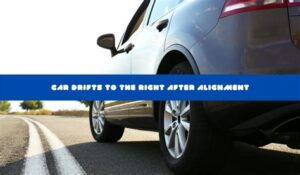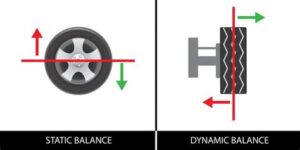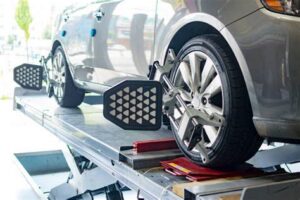Ensuring your vehicle operates smoothly is key to a safe and enjoyable driving experience, and one crucial aspect of this is proper wheel alignment. But how can you tell if your car is in need of alignment? From strange steering behaviors to uneven tire wear, there are several signs that can indicate an alignment issue. In this article, we’ll explore these critical warning signs, the impacts of misalignment on your tires and vehicle handling, and the importance of maintaining regular wheel alignment. Whether you’re a seasoned driver or a new car owner, understanding these elements can enhance your vehicle’s performance and longevity. Let’s delve into the essential aspects of car alignment and how you can keep your ride in top shape.
Signs That Indicate Your Car Needs Alignment
Understanding how can you identify if your car requires alignment is essential for maintaining vehicle health and safety. Here are several key signs to watch for:
- Uneven Tire Wear: If you notice any irregular patterns on your tires, such as bald spots or excessive wear on one side, this could indicate misalignment.
- Pulling to One Side: When driving straight, if your car drifts to the left or right without you steering, it’s a clear sign your wheels may be out of alignment.
- Steering Wheel Off-Center: If your steering wheel is tilted when driving straight, this misalignment can affect both vehicle control and comfort.
- Vibration in the Steering Wheel: Persistent vibrations while driving can also be a sign that the wheels are not aligned correctly, impacting your car’s handling.
- Handling Issues: If your car feels unsteady or you struggle to control it, alignment problems may be at the root of these issues.
By keeping an eye out for these signs, you can be proactive about your vehicle’s upkeep and address alignment issues before they lead to more serious problems.
How Can Uneven Tire Wear Affect Your Vehicle
Uneven tire wear is not just a cosmetic issue; it can significantly impact your vehicle’s performance and safety. When tires wear unevenly, they can lead to a range of problems that affect both your driving experience and the longevity of your car. Here are several key points to consider:
| Type of Uneven Wear | Possible Effects |
|---|---|
| Edge Wear | Can lead to loss of traction, increased braking distance, and reduced cornering stability. |
| Cup Wear | Causes vibrations that can affect steering and could indicate suspension issues. |
| Center Wear | Usually results from over-inflation and can decrease tire lifespan and fuel efficiency. |
| Total Wear | Indicates the need for immediate replacement of tires for safety reasons. |
When you ask yourself how can uneven tire wear affect your vehicle, it’s crucial to recognize that it can lead to:
- Decreased fuel efficiency, causing more frequent visits to the gas station.
- Increased risk of tire blowouts, which can endanger your safety.
- Higher repair costs due to the need for premature tire replacements or repairs in other vehicle components.
A vehicle that requires alignment can cause tires to wear unevenly, creating a vicious cycle that not only affects handling but can also lead to more serious mechanical issues over time. Consequently, staying vigilant to signs of misalignment and addressing them timely is essential for the overall health of your vehicle.
Importance of Regular Wheel Alignment for Your Car
Regular wheel alignment is crucial for maintaining the performance and safety of your vehicle. Not only does proper alignment enhance driving comfort, but it also contributes to the overall longevity of your car. Here are several key reasons why you should prioritize regular wheel alignment:
- Improved Handling: Misalignment can significantly affect your car’s steering response. Regular alignment ensures your vehicle handles properly, providing better control during turns and maneuvers.
- Extended Tire Life: Misaligned wheels lead to uneven tire wear. By keeping your wheels aligned, you can extend the lifespan of your tires, saving you money on replacements.
- Better Fuel Efficiency: A misaligned vehicle can cause increased rolling resistance, resulting in decreased fuel efficiency. Proper alignment helps your car run more efficiently, leading to better mileage.
- Enhanced Safety: Maintaining correct alignment is vital for safe driving. Misalignment can cause your vehicle to pull to one side, increasing the risk of accidents. Regular checks ensure that your car remains stable and secure on the road.
- Cost Savings: Investing in regular wheel alignment can prevent more expensive repairs in the future. By detecting issues early, you can avoid more significant problems that arise from neglect.
Understanding how can regular wheel alignment benefit your car can help you make informed decisions about your vehicle maintenance. Prioritizing alignment checks not only enhances performance but also boosts safety and efficiency, providing you with peace of mind while driving.
Symptoms of Misalignment That You Shouldn’t Ignore
When it comes to maintaining your vehicle, understanding the how can signs of misalignment save you from more significant issues down the road. Here are several symptoms that indicate your car may need an alignment:
| Symptom | Possible Cause |
|---|---|
| Vehicle pulls to one side | Misaligned wheels |
| Uneven tire wear | Incorrect wheel angles |
| Steering wheel is off-center | Alignment issue |
| Steering wheel vibrations | Worn suspension components |
| Difficulty in steering | Alignment and suspension problems |
If you notice any of these symptoms, it’s crucial to address the issue promptly. Delaying necessary alignment can lead to further complications, including reduced fuel efficiency and compromised handling. Regular checks can help ensure that your vehicle remains safe and performs optimally.
How Can You Improve Your Car’s Handling with Alignment
Ensuring that your vehicle is properly aligned can significantly enhance its handling characteristics. When the wheels are aligned correctly, your car will respond more adeptly to steering inputs and provide a smoother driving experience. Here are some key ways how can you improve your car’s handling through alignment:
- Adjust Toe Settings: Proper toe alignment allows your tires to point straight ahead, minimizing drag and improving responsiveness. If the toe settings are off, it can lead to wandering or pulling to one side.
- Maintain Camber Angles: Adjusting camber angles ensures that your tires maintain optimal contact with the road. A negative camber can improve cornering, while a positive camber can cause reduced stability.
- Set Caster Angles: Caster angle influences steering stability and self-centering characteristics. Properly adjusted caster angles contribute to better handling during straights and corners.
- Regular Inspections: Frequent examination of your vehicle’s alignment can preempt handling issues. This includes checking suspension components for wear that might affect alignment.
- Use Quality Tires: Ensure your tire selection complements your alignment specifications. High-quality tires can enhance grip and traction, contributing to a better handling experience.
Understanding how can you enhance your car’s handling through alignment adjustments is essential for both safety and driving pleasure. Regular maintenance and prompt alignment services will ensure that your vehicle performs at its best every time you hit the road.
Frequently Asked Questions
What are the signs that indicate my car needs an alignment?
Common signs include uneven tire wear, pulling to one side while driving, and a crooked steering wheel when driving straight.
How does improper alignment affect my tires?
Improper alignment can cause uneven tire wear, leading to premature tire replacement and decreased fuel efficiency.
Can misalignment affect my vehicle’s performance?
Yes, misalignment can significantly impact handling, steering precision, and overall driving safety.
How often should I check my car’s alignment?
It’s advisable to check your alignment every 6,000 to 10,000 miles or any time you notice symptoms of misalignment.
Is it possible to do an alignment check at home?
While some basic checks can be done at home, professional assessment with specialized equipment is recommended for accurate results.
What causes a car to become misaligned?
Common causes include hitting potholes, curb impacts, or gradually due to the normal wear and tear of suspension components.
How much does a wheel alignment typically cost?
The cost of a wheel alignment can vary widely but typically ranges from $50 to $100, depending on the location and type of vehicle.





